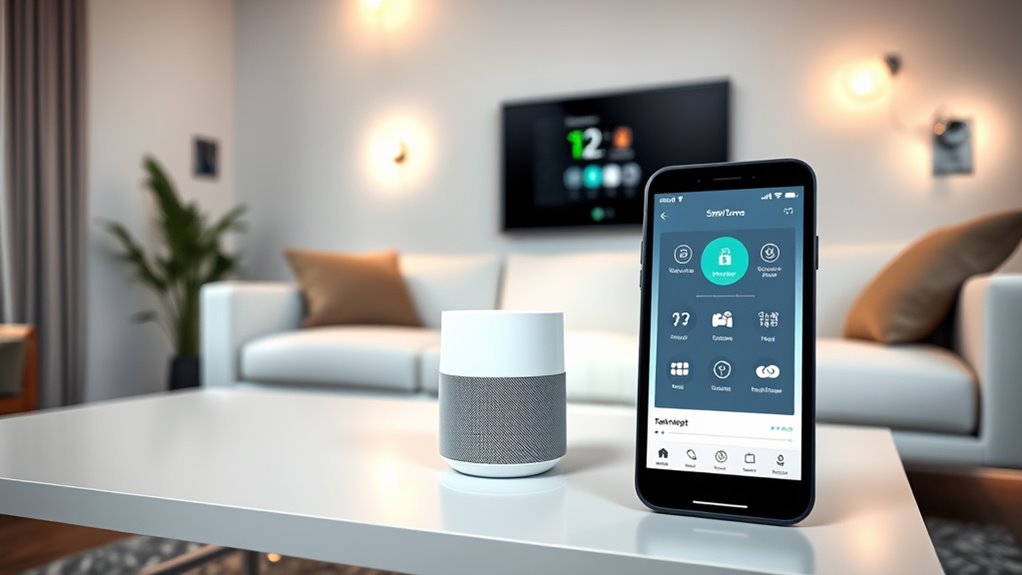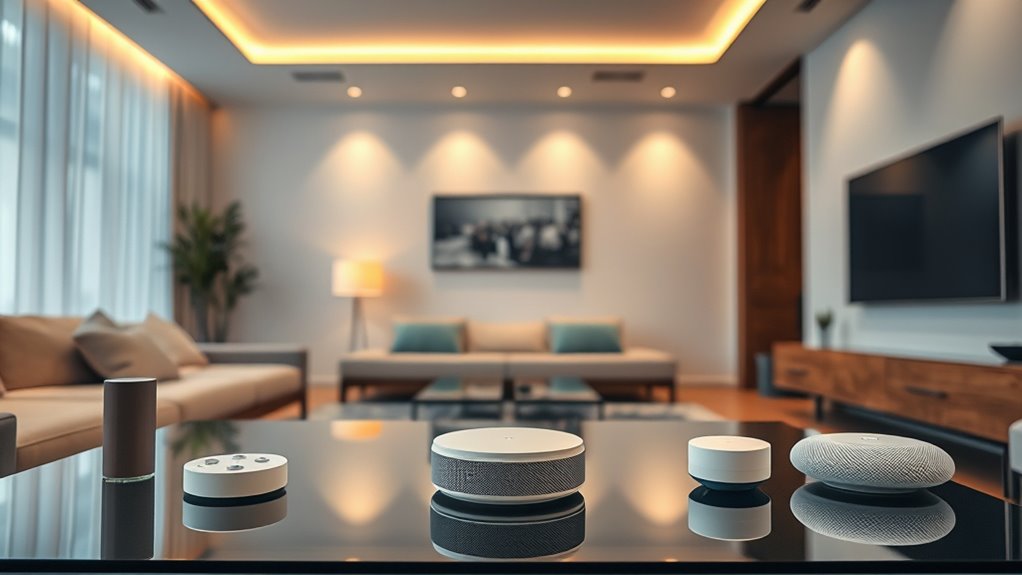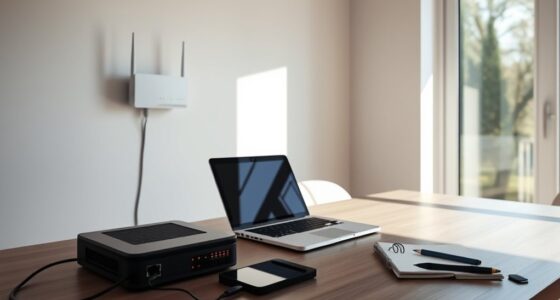A beginner’s guide to smart home devices shows you how to control your household easily using technology. Start with a central hub like Amazon Alexa, Google Nest, or Apple HomePod to manage your smart lights, thermostats, security cameras, and locks through voice commands or apps. These devices save energy and boost safety while making daily tasks more convenient. Keep exploring to learn about organizing your smart home and creating seamless automation that fits your lifestyle.
Key Takeaways
- Start with a central smart home hub like Amazon Echo, Google Nest, or Apple HomePod for easy device integration.
- Choose essential devices such as smart lights, thermostats, and locks to simplify home automation.
- Ensure compatibility with your preferred voice assistant for seamless voice control.
- Use smartphone apps to remotely manage and schedule devices for convenience and energy savings.
- Expand gradually by adding sensors and security devices to enhance safety and home management.

If you’re new to smart home technology, it can seem overwhelming at first, but understanding the basics can help you make informed choices. Smart devices are designed to make your life more convenient, efficient, and secure, but knowing how they work together is key. The central hub for many smart homes is a smart speaker or voice assistant, like Amazon Echo with Alexa, Google Nest with Google Assistant, or Apple HomePod with Siri. These devices allow you to control your smart home with simple voice commands, eliminating the need to manually operate switches or apps. You can turn on lights, adjust your thermostat, lock doors, play music, and more, all through voice control. When choosing a smart speaker, consider which ecosystem it’s compatible with, so your devices work seamlessly together.
Smart speakers and voice assistants simplify control of your smart home with voice commands.
Smart lighting is another core element of a smart home. Smart bulbs and switches let you customize your lighting with features like dimming, color changes, and scheduling. You can create different ambiances for various occasions or automate lighting to turn off when you leave a room or based on occupancy detected by motion sensors. These systems not only enhance comfort but also save energy by ensuring lights aren’t on when they’re not needed. Popular brands often work with major voice assistants, making it easy to control your lights through voice commands or smartphone apps.
Smart thermostats are designed to optimize your home’s climate while saving energy. They learn your preferences over time and automatically adjust heating and cooling to keep you comfortable. Many models use geofencing technology, which activates the thermostat when your smartphone approaches home, so you arrive to a pleasant environment. You can control your thermostat remotely through apps, giving you flexibility whether you’re at work or on vacation. Some integrate with other smart devices, such as sensors or smart vents, to improve automation and efficiency, helping reduce your utility bills. Additionally, understanding the industry trends can help you select the most compatible and innovative devices for your setup.
Security is a vital aspect of a smart home, and devices like Wi-Fi cameras, video doorbells, and smart locks provide peace of mind. These allow you to monitor your property remotely, receive alerts for suspicious activity, and control access through digital keys or codes. Voice assistants can also help with locking or unlocking doors with simple commands, adding convenience and security. Automation rules can be set up to lock doors at night or trigger alarms if unusual activity is detected, creating a safer environment.
Smart plugs and outlets are an affordable entry point into home automation. They turn ordinary appliances into smart devices, letting you control them remotely or schedule their operation. For example, you can turn on your coffee maker in the morning or turn off a fan when you leave the house, all via your phone or voice commands. They’re compatible with voice assistants, making them straightforward to integrate. Lastly, sensors like motion detectors, contact sensors, and environmental monitors help automate routines and enhance security by detecting activity or changes in your home environment. By understanding these foundational devices, you can start building a smart home tailored to your needs.
Frequently Asked Questions
Are Smart Home Devices Secure From Hacking?
Smart home devices aren’t completely secure from hacking. Over half have critical vulnerabilities, and cyberattacks are increasing rapidly, with malware and DDoS attacks rising markedly in 2024. You can improve security by regularly updating your devices, monitoring network activity, and reinforcing your network defenses. Staying informed about common vulnerabilities and adopting best practices helps protect your devices and personal data from potential hackers.
Can I Use Smart Devices Without Wi-Fi?
Yes, you can use smart devices without Wi-Fi. Many devices, like Zigbee, Z-Wave, and Bluetooth-enabled products, work locally without internet. You’ll need a compatible hub or controller, such as Hubitat or Home Assistant, to manage these devices offline. This setup offers benefits like increased security, reliability during outages, and cost savings. Just remember, some advanced features may require internet access, but basic controls remain functional offline.
What Is the Average Cost of a Smart Home System?
Imagine you’re stepping into a modern castle—your smart home system costs can vary widely. On average, a basic starter kit runs between $40 and $200, including essential devices like bulbs and plugs. More advanced systems with security cameras, sensors, and hubs typically range from $200 to $600. Your total depends on how many devices you add, their quality, and the ecosystem you choose, making customization key to your budget.
How Energy-Efficient Are Smart Home Devices?
Smart home devices are highly energy-efficient choices. They can cut your energy use by 30-40% on average, with some devices like smart thermostats saving up to 40% annually. By optimizing heating, cooling, lighting, and power management, these devices help reduce waste. To maximize savings, you need to use them effectively and verify they’re compatible. Overall, smart devices make your home more efficient and eco-friendly.
Are Smart Devices Suitable for Elderly or Disabled Users?
You might wonder if smart devices suit elderly or disabled users. The good news is, many are designed with features like voice control and accessibility options that make controlling your environment easier. They can enhance safety, independence, and health monitoring. Although there are some challenges like cost and learning curves, ongoing innovations and support are making smart devices more adaptable, helping you live more comfortably and securely.
Conclusion
Now that you’ve explored the basics of smart home devices, you’re ready to turn your house into a futuristic haven. Think of your smart home as a trusty steed, ready to respond at your command—whether it’s adjusting the thermostat or lighting your way like a lantern in a dark alley. Embrace these devices, and you’ll enjoy greater comfort and convenience. Just like a well-stocked workshop, your smart home will simplify your life and make everyday living feel like magic.










